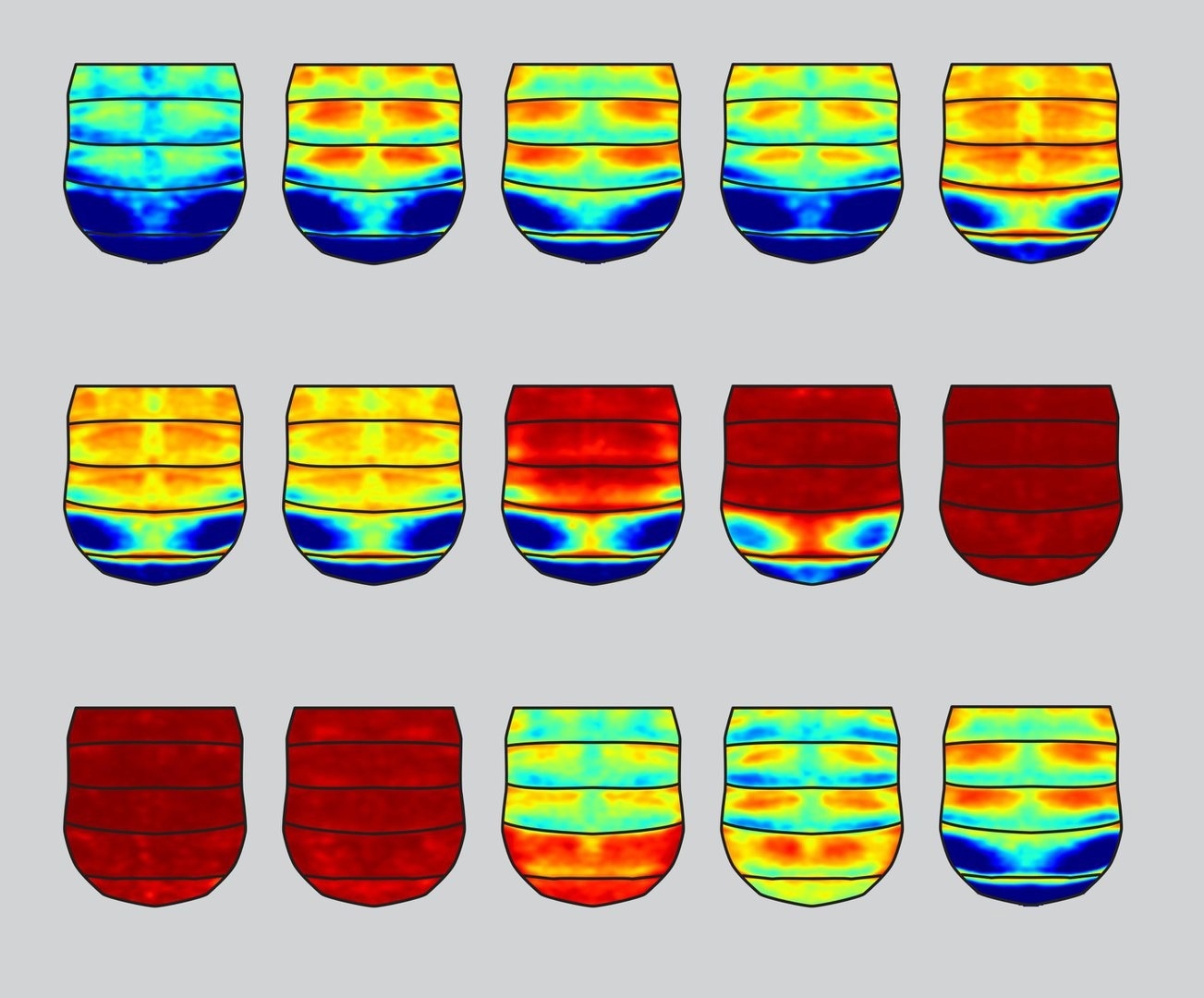The DNA of plants and animals contains their blueprint. However, genes, the instructions for generating proteins, are found in a very small portion of the genome, roughly 2% in mammals. The remainder largely determines how many of these genes' transcripts are created and how many proteins are synthesized from them.
 The images show the abdomen of flies in which a specific enhancer region has been modified. - Depending on how much and which part of the region is modified, different areas of the pigment pattern change. This shows that the region contains several non-modular enhancers (blue = strong gene expression; red = weak gene expression). Image Credit: Mariam Museridze / Universität Bonn
The images show the abdomen of flies in which a specific enhancer region has been modified. - Depending on how much and which part of the region is modified, different areas of the pigment pattern change. This shows that the region contains several non-modular enhancers (blue = strong gene expression; red = weak gene expression). Image Credit: Mariam Museridze / Universität Bonn
Some of these “enhancers” regulatory sequences function similarly to the dimmer switches that control the lighting in the living room. In fact, when and where a specific gene is needed, they specifically boost its expression. Morphology-controlling genes frequently react to multiple separate enhancers, each of which controls the gene's expression in a distinct body part.
Enhancers Controlling Drosophila Coloration
Enhancers were formerly believed to be modular. Each enhancer occupies a separate region of DNA, as the term suggests.
“We have shown, however, that this is not absolutely true," explained Mariam Museridze, Study First Author and a PhD candidate in the group of Professor Dr. Nicolas Gompel at the Bonn Institute of Organismic Biology. Gompel is also a part of the University of Bonn's 'Life & Health' Transdisciplinary Research Area (TRA).
The scientists investigated the regulation of a gene named yellow in the fruit fly Drosophila. The insect produces the brownish pigment melanin as a result of this gene. Many enhancers regulate the activity of yellow. For instance, one of them is in charge of giving the maggots' teeth their color, and another is in charge of giving the fly's abdomen its striped design.
“We have taken a closer look at two of these enhancers," said Museridze.
The first regulates how the wings' color pattern is formed, and the second regulates how the head, thorax, and abdomen are colored. Throughout the fly's transformation, both are operating simultaneously.
The group found that, contrary to expectations, the body enhancer is not found in a separate DNA region from the wing enhancer. Rather, large DNA areas are part of both gene switches, meaning that they affect the body's and the wing's coloring.
The findings imply that the genome's regulatory sequence architecture is far more intricate than previously believed. This has broad ramifications for how qualities evolve. Enhancers are essential to this process.
Enhancers as an Evolutionary Playground
This is because a mutation in a gene (the DNA sequence that holds the instructions for creating the protein) would result in major issues or possibly death for many proteins. After all, they are so vital to an organism.
Therefore, during evolution, genes that determine body structure, such as the number of wings or legs, seldom ever change. A solution to this problem is provided by enhancers, which, when they mutate, alter the activity of the related gene, but only in a particular tissue and at a certain moment.
The cost of mutating an enhancer is therefore often lower than the cost of mutating the gene directly.”
Mariam Museridze, Study First Author and PhD Candidate, University of Bonn
This facilitates the emergence of novel features during evolution. Similar to creating a cake, the proportions of eggs, flour, milk, and sugar can result in various kinds of dough. The enhancers in this metaphor would be in charge of the amount of ingredients rather than their kind.
Using sawdust instead of flour is an example of a genetic mutation, which is similar to inadvertently substituting one component for another. The end product will undoubtedly taste bad. The amount of flour, however, would be altered by a mutation in an enhancer.
If enhancers are not as modular as we thought, this means that mutations in them can have much broader effects.”
Mariam Museridze, Study First Author and PhD Candidate, University of Bonn
This implies that a mutation of this kind might simultaneously alter the quantity of multiple elements. Even while their sequences are shared and interlaced, it is also feasible that the enhancers maintain their independence and continue to regulate the quantity of a particular element.
We now want to investigate these possibilities in more detail. We also want to find out how general our findings are and how this affects our understanding of evolutionary mechanisms.”
Dr. Nicolas Gompel, Professor, University of Bonn
Source:
Journal reference:
Museridze, M., et al. (2024) Entangled and non-modular enhancer sequences producing independent spatial activities. Science Advances. doi.org/10.1126/sciadv.adr9856.